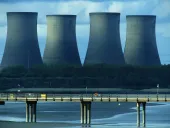3 Trends Transforming Gas Investment Opportunities in Asia
By Lee MatherBy Lee Mather, Black & Veatch
Nations across Southeast Asia are seeking to expand their gas infrastructure to support the increased share of renewable energy in their generation mix.
In Vietnam, a 3,000-megawatt (MW) liquified natural gas (LNG)-to-power complex is expected to be constructed in the province of Long An. According to its draft 8th Power Development Plan (PDP8), Vietnam plans to increase gas thermal power in its energy mix from 13 percent currently to 24 percent by 2045. The draft covers the period 2021 through 2030, with a vision to 2045.
In the Philippines, a long-term electricity supply contract for 1,200 MW has been awarded to an LNG-based power project. The country aspires to develop an LNG hub to serve local and regional energy needs. The country has approved the permits of five proposed LNG Regasification Terminal Projects targeted for operation from 2022 to 2025.
In Thailand, a 1400 MW natural gas-fired combine cycle turbine facility is expected to be built west of Bangkok. The feasibility of developing a five million tons per year floating storage re-gasification unit (FSRU) in the Gulf of Thailand is being studied.
According to the Black & Veatch Strategic Directions: Electric Industry Asia 2021 report, two thirds of the region’s electric industry participants believe natural gas has a future beyond 2035 as a significant component of the grid.
The question is how gas infrastructure will play a role and what that means for the region’s power and liquified natural gas (LNG) industries.
Three trends are reshaping how we consider and plan for the long-term use of gas infrastructure in Asia. These trends influence the opportunities to maximize returns from investments in gas-fired generation, LNG receiving terminals and regasification facilities.
Black & Veatch foresees investment in gas infrastructure in Asia as critical in both de-risking power generation portfolios and achieving an affordable transition to a decarbonized and stable power supply in Asia.
Flexible and Fast Grid Stabilizer
As utilities replace reliable, dispatchable generation assets with intermittent power sources, Asia’s lower-carbon energy systems will need highly flexible, dispatchable generation to maintain grid reliability and resiliency.
Today’s advanced gas turbines in a simple cycle configuration can supply more than 400 MW to the grid in 10 minutes and are designed to reach full combined cycle load in 30 minutes to one hour. New gas turbine technologies can now operate at very low loads of less than 25 percent of their baseload capacity in some cases and ramp at 10 to 15 percent of their full load capacity per minute.
Asia’s utility leaders will need to map out future operational scenarios and consider efficiency trade-offs. For example, while reducing near-term operational efficiencies, allowances should be considered in the initial design philosophy (such as, additional capacity on steam turbine, boiler feed pumps, and balance of plant equipment) for adopting gas turbine upgrades that may yield substantial performance improvements over its lifetime, keeping it near the top of the dispatch order.
Similarly, looking beyond baseload heat rate and designing to maintain low heat rates across a broad operating range would enable greater gas turbine flexibility and its evolved role in future energy systems.
As grids demand more flexibility from large combined cycle plants due to increasing renewable deployments, plant startup profiles become more crucial and initial design should incorporate appropriate measures to allow fast start and higher load ramping capabilities. Additionally, as grids get saturated with intermittent generation assets, Asian markets will start the shift towards load correction plants. Gas engine-based plants or smaller gas turbine-based plants will make a comeback in near future.
Opportunity: Considering its cost, flexibility, and emissions profile, with the right planning, gas turbine generation has a place in Asia’s fuel mix for years to come as a high efficiency, reliable baseload source, as well as by serving as a complement to systems with wind and solar generation.
Bridge to Decarbonization and Replacing with Hydrogen
Gas turbine assets are likely to have significant commercial value beyond 2035, or even 2050, operating in a future net-zero world in Asia.
Futureproofing starts by designing in the flexibility to operate across services ranging from energy storage to baseload generation while also considering revenue opportunities in ancillary and grid reliability services. In addition, while considering the emergence of cost-effective carbon capture utilization and storage technologies, another future pathway leads to gas turbines’ role in accelerating the use of clean-burning hydrogen generation – in part or full.
Today’s most advanced gas turbines can utilize 30 to 50 percent hydrogen fuel content. Each of the major gas turbine manufacturers are making substantial progress on a path to supporting 100 percent hydrogen fuel within this decade. It is also expected that the manufacturers will design upgraded technologies that can be retrofitted into these machines.
Opportunity: Thinking of turbines operating with hydrogen can reshape investment prospects for power developers. With minimal initial investments, utilities and investors can plan and design for conversion to 100 percent hydrogen or other future scenarios that increase their returns over prolonged lifecycles beyond typical 30 years of service.
LNG-to-Power and LNG-to-Ammonia
One major challenge facing Asia’s gas-fired generation facilities concerns supply; most gas fields are not located near high-demand electricity centers and often separated by seas. LNG has served as the medium-for-transport supplying gas to many locations throughout Asia.
The case for integrated regasification and power generation is compelling, whether fully integrated or partial. For example, for a combined cycle facility with a nominal output of 700 MW and a net present value (NPV) of US$200 million over 15 years, it is estimated that integrating a nearshore floating regasification unit as part of the combined cycle facility could earn an additional US$300 million given gains expected in power output and efficiency. Such benefits should be considered by investors in Southeast Asia where sites near coastal waters are plentiful.
In addition, building both a gas-fired power plant and LNG regasification terminal opens further commercial opportunities to potentially market LNG to regional enterprises through a hub-and-spoke concept. Such opportunities may accelerate as industrial customers seek to switch from diesel to less carbon-intensive gas.
Looking over a longer investment period, there is a potential synergy between LNG and ammonia infrastructure, given the adaptability of LNG infrastructure and ability to convert for use with ammonia.
Known for its role in fertilizer production, ammonia is gaining attention as a stable energy carrier for hydrogen whose volumetric energy density makes storage and transport technically and economically challenging. Ammonia is more energy dense than liquid hydrogen and is also easily liquified for storage and shipment in the same fashion as LNG.
Opportunity: All these scenarios call for reconsidering gas investment more holistically and considering risks across power generation, LNG receiving terminals and regasification infrastructure. Rewards are evident for understanding and planning around the full value chain alongside likely future market shifts.
Conclusion
Maximizing these operational advantages will require thinking ahead in the early project development stages. Gas turbine investments are set to yield significant returns for investor for many years in Asia. However, the industry will need to consider the functionality of gas infrastructure in new ways, plan for and anticipate change, and build in greater levels of adaptability to future market conditions as the world drives toward a decarbonized and sustainable future.




















 Advertise
Advertise







